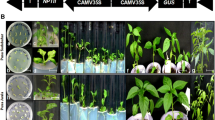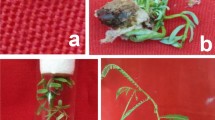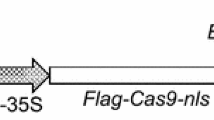Abstract
Efficient and genotype-independent in vitro regeneration is an essential prerequisite for incremental trait improvement in peanut (Arachis hypogaea L.) via genetic transformation. We have optimized a facile and rapid method to obtain direct shoot organogenesis from cotyledonary node (CN) explants excised from peanut seedlings germinated on cytokinin-supplemented Murashige and Skoog (MS) basal salt medium. Starting with mature embryos, shoot induction occurred in approximately 7 weeks, followed by 4 weeks for rooting of excised shoots and 3 weeks of acclimatization of regenerated plantlets in soil. The regeneration and transformation system described here is time-efficient, yielding greenhouse-acclimatized plantlets within 14 weeks, in contrast to 12–14 months required for initiating and regenerating somatic embryogenic cultures, currently the most tractable method available for peanut transformation. The highest shoot induction frequency and shoot quality was obtained with 6.66 μM 6-benzylaminopurine, followed by adequate root induction at 5.37 μM α-Naphthaleneacetic acid. New Mexican Valencia A was chosen for Agrobacterium-mediated transformation. Stable GUS expression from pWBvec10a was obtained at a transformation rate of 1.25 %. Furthermore, results from genomic PCR and Southern blot analyses showed that 14 out of 576 putative transgenic regenerants contained transgene pSag12::IPT, therefore yielding a total transformation rate of 2.43 %. The cotyledonary node-based direct regeneration system described here is time-efficient and amenable to Agrobacterium-mediated transformation, and therefore should be further explored for peanut transgenic improvement.









Similar content being viewed by others
Abbreviations
- 2,4-D:
-
2,4-dichlorophenoxyacetic acid
- BAP:
-
6-benzylaminopurine
- CN:
-
Cotyledonary node
- MS:
-
Murashige and Skoog (1962) medium
- NAA:
-
α-naphthalene acetic acid
- RIM:
-
Root initiation medium
- SEM:
-
Shoot elongation medium
- SIM:
-
Shoot initiation medium
- TDZ:
-
Thidiazuron
References
Anuradha TS, Jami SK, Datla RS, Kirti PB (2006) Genetic transformation of peanut (Arachis hypogaea L.) using cotyledonary node as explant and a promoterless gus::nptII fusion gene based vector. J Biosci 31:235–246
Anuradha TS, Divya K, Jami SK, Kirti PB (2008) Transgenic tobacco and peanut plants expressing a mustard defensin show resistance to fungal pathogens. Plant Cell Rep 27:1777–1786
Arun M, Subramanyam K, Theboral J, Ganapathi A, Manickavasagam M (2014) Optimized shoot regeneration for Indian soybean: the influence of exogenous polyamines. Plant Cell Tiss Org 117:305–309
Asif MA, Zafar Y, Iqbal J, Iqbal MM, Rashid U, Ali GM, Arif A, Nazir F (2011) Enhanced expression of AtNHX1, in transgenic groundnut (Arachis hypogaea L.) improves salt and drought tolerence. Mol Biotechnol 49:250–256
Baker CM, Durham RE, Burns JA, Parrott WA, Wetzstein HY (1995) High frequency somatic embryogenesis in peanut (Arachis hypogaea L.) using mature, dry seed. Plant Cell Rep 15:38–42
Bhatnagar M, Prasad K, Bhatnagar-Mathur P, Narasu ML, Waliyar F, Sharma KK (2010) An efficient method for the production of marker-free transgenic plants of peanut (Arachis hypogaea L.). Plant Cell Rep 29:495–502
Bhatnagar-Mathur P, Devi MJ, Vadez V, Sharma KK (2009) Differential antioxidative responses in transgenic peanut bear no relationship to their superior transpiration efficiency under drought stress. J Plant Physiol 166:1207–1217
Burns SP, Gallo M, Tillman BL (2012) Expansion of a direct shoot organogenesis system in peanut (Arachis hypogaea L.) to include US cultivars. In Vitro Cell Dev-Pl 48:58–66
Carimi F, Zottini M, Formentin E, Terzi M, Schiavo FL (2003) Cytokinins: new apoptotic inducers in plants. Planta 216:413–421
Chandra A, Pental D (2003) Regeneration and genetic transformation of grain legumes: An overview. Curr Sci India 84:381–387
Cheng TY, Saka H, Voqui-Dinh TH (1980) Plant regeneration from soybean cotyledonary node segments in culture. Plant Sci Lett 19:91–99
Cheng M, Jarret RL, Li Z, Xing A, Demski JW (1996) Production of fertile transgenic peanut (Arachis hypogaea L.) plants using Agrobacterium tumefaciens. Plant Cell Rep 15:653–657
Dai S, Zheng P, Marmey P, Zhang S, Tian W, Chen S, Beachy RN, Fauquet C (2001) Comparative analysis of transgenic rice plants obtained by Agrobacterium-mediated transformation and particle bombardment. Mol Breed 7:25–33
Dang W, Wei ZM (2009) High frequency plant regeneration from the cotyledonary node of common bean. Biol Planta 53:312–316
Das A, Kumar S, Nandeesha P, Yadav IS, Saini J, Chaturvedi SK, Datta S (2014) An efficient in vitro regeneration system of fieldpea (Pisum sativum L.) via. shoot organogenesis. J Plant Biochem Biot 23:184–189
Dellaporta SL, Wood J, Hicks JB (1983) Isolation of DNA from higher plants. Plant Mol Biol Rep 4:19–21
Dodo HW, Konan KN, Chen FC, Egnin M, Viquez OM (2008) Alleviating peanut allergy using genetic engineering: the silencing of the immunodominant allergen Ara h 2 leads to its significant reduction and a decrease in peanut allergenicity. Plant Biotechnol J 6:135–145
Doyle JJ, Doyle JL (1990) Isolation of plant DNA from fresh tissue. Focus 12:13–15
Eapen S, George L (1994) Agrobacterium tumefaciens mediated gene transfer in peanut (Arachis hypogaea L.). Plant Cell Rep 13:582–586
Egnin M, Mora A, Prakash CS (1998) Factors enhancing Agrobacterium tumefaciens-mediated gene transfer in Peanut (Arachis hypogaea L.). In Vitro Cell Dev-Pl 34:310–318
Gan S, Amasino RM (1995) Inhibition of leaf senescence by autoregulated production of cytokinin. Science 270:1986–1988
Gordon-Kamm WJ, Spencer TM, Mangano ML, Adams TR, Daines RJ, Start WG, O’Brian JV, Chambers SA, Adams JWR, Willetts NG, Rice TB, Mackey CJ, Krueger W, Kausch AR, Lemaux PG (1990) Transformation of maize cells and regeneration of fertile transgenic plants. Plant Cell 2:603–618
Gray DJ, Benton CM (1991) In vitro micropropagation and plant establishment of muscadine grape cultivars (Vitis rotundifolia). Plant Cell Tissue Org 27:7–14
Hsi DC, Finkner RE (1972) Registration of New Mexico Valencia A peanut. Crop Sci 12:256
Ignacimuthu S (2000) Agrobacterium mediated transformation of Vigna sesquipedalis Koern (Asparagus bean). Indian J Exp Biol 38:493–498
Iqbal MM, Nazir F, Ali GM (2012) Over expression of rice chitinase gene in transgenic peanut (Arachis hypogaea L.) improves resistance against leaf spot. Mol biotech 50:129–136
Jackson JA, Hobbs SLA (1990) Rapid multiple shoot production from cotyledonary node explants of pea (Pisum sativum L.). In Vitro Cell Dev B 26:835–838
Jaiwal PK, Kumari R, Ignacimuthu S, Potrykus I, Sautter C (2001) Agrobacterium tumefaciens-mediated genetic transformation of mungbean (Vigna radiata L. Wilczek)—a recalcitrant grain legume. Plant Sci 161:239–247
Kane ME, Philman NL, Jenks MA (1994) A laboratory exercise to demonstrate direct and indirect shoot organogenesis using internodes of Myriophyllum aquaticum. Horttechnology 4:317–320
King JC, Blumberg J, Ingwersen L, Jenab M, Tucker KL (2008) Tree nuts and peanuts as components of a healthy diet. J Nutr 138:1736S-1740S
Kochert G, Stalker HT, Gimenes MA, Galgaro ML, Lopes CR, Moore K (1996) RFLP and cytogenetic evidence on the origin and evolution of allotetraploid domesticated peanut, Arachis hypogaea (Leguminosae). Am J Bot 83:1282–1291
Kokalis-Burelle N, Porter DM, Rodriguez-Kabana R, Smith DH, Subrahmanyam P (1997) Compendium of peanut diseases, 2nd edn. APS Press, St. Paul
Li Z, Jarret RL, Demski JW (1997) Engineered resistance to tomato spotted wilt virus in transgenic peanut expressing the viral nucleocapsid gene. Transgenic Res 6:297–305
Lu CY (1993) The use of thidiazuron in tissue culture. In Vitro Cell Dev Biol Plant 29:92–96
Mahmoudian M, Yücel M, Öktem HA (2002) Transformation of lentil (Lens culinaris M.) cotyledonary nodes by vacuum infiltration of Agrobacterium tumefaciens. Plant Mol Biol Rep 20(3):251–257
Mallikarjuna N, Varshney RK (Eds.) (2014) Genetics, genomics and breeding of peanuts. CRC Press, Boca Raton, p 199
McKently AH (1991) Direct somatic embryogenesis from axes of mature peanut embryos. In Vitro Cell Dev-Pl 27:197–200
McKently AH, Moore GA, Doostdar H, Niedz RP (1995) Agrobacterium-mediated transformation of peanut (Arachis hypogaea L.) embryo axes and the development of transgenic plants. Plant Cell Rep 14:699–703
Mlejnek P (2013) Cytokinin-induced cell death is associated with elevated expression of alternative oxidase in tobacco BY-2 cells. Protoplasma 250:1195–1202
Mohamed MF, Read PE, Coyne DP (1992) Dark preconditioning, CPPU, Thidiazuron promote shoot organogenesis on seedling node explants of common and faba beans. J Am Soc Hortic Sci 117:668–672
Murashige T, Skoog F (1962) A revised medium for rapid growth and bio assays with tobacco tissue cultures. Physiol Planta 15:473–497
Norden AJ, Lipscomb RW, Carver WA (1969) Registration of florunner peanuts1 (Reg. no. 2). Crop Sci 9:850
Novák J, Pavlů J, Novák O, Nožková-Hlaváčková V, Špundová M, Hlavinka J, Koukalová Š, Skalák J, Černý M, Brzobohatý B (2013) High cytokinin levels induce a hypersensitive-like response in tobacco. Ann Bot 112:41–55
Olhoft PM, Somers DA (2001) L-Cysteine increases Agrobacterium-mediated T-DNA delivery into soybean cotyledonary-node cells. Plant Cell Rep 20:706–711
Ozias-Akins P, Anderson WF, Holbrook CC (1992) Somatic embryogenesis in Arachis hypogaea L.: genotype comparison. Plant Sci 83:103–111
Ozias-Akins P, Schnall JA, Anderson WF, Singsit C, Clemente TE, Adang MJ, Weissinger AK (1993) Regeneration of transgenic peanut plants from stably transformed embryogenic callus. Plant Sci 93:185–194
Paz MM, Martinez JC, Kalvig AB, Fonger TM, Wang K (2006) Improved cotyledonary node method using an alternative explant derived from mature seed for efficient Agrobacterium-mediated soybean transformation. Plant Cell Rep 25:206–213
Prakash NS, Pental D, Bhalla-Sarin N (1994) Regeneration of pigeonpea (Cajanus cajan) from cotyledonary node via multiple shoot formation. Plant Cell Rep 13:623–627
Prasad K, Bhatnagar-Mathur P, Waliyar F, Sharma KK (2013) Overexpression of a chitinase gene in transgenic peanut confers enhanced resistance to major soil borne and foliar fungal pathogens. J Plant Biochem Biotechnol 22:222–233
Preece JE, Imel MR (1991) Plant regeneration from leaf explants of Rhododendron ‘PJM Hybrids’. Scientia horticulturae 48:159–170
Qin H, Gu Q, Zhang J, Sun L, Kuppu S, Zhang Y, Burow M, Payton P, Blumwald E, Zhang H (2011) Regulated expression of an isopentenyl- transferase gene (IPT) in peanut significantly improves drought tolerance and increases yield under field conditions. Plant Cell Physiol 52:1904–1914
Rana K, Mohanty IC (2012) In vitro regeneration and genetic transformation in groundnut (Arachis hypogaea L. cv. Smruti) for abiotic stress tolerance mediated by Agrobacterium tumefaciens. J Today Biol Sci Res Rev 1:62–85
Saini R, Jaiwal PK (2007) Agrobacterium tumefaciens-mediated transformation of blackgram: an assessment of factors influencing the efficiency of uidA gene transfer. Biol planta 51:69–74
Sanyal I, Singh AK, Amla DV (2003) Agrobacterium tumefaciens-mediated transformation of chickpea (Cicer arietinum L.) using mature embryonic axes and cotyledonary nodes. Indian J Biotechnol 2:524–532
Satyavathi V, Prasad V, Shaila M, Sita LG (2003) Expression of hemagglutinin protein of Rinderpest virus in transgenic pigeon pea [Cajanus cajan (L.) Millsp.] plants. Plant Cell Rep 21:651–658
Sharma KK, Anjaiah VV (2000) An efficient method for the production of transgenic plants of peanut (Arachis hypogaea L.) through Agrobacterium tumefaciens-mediated genetic transformation. Plant Sci 159:7–19
Shokes FM, Culbreath AK (1997) Early and late leaf spots. In Kokalis-Burell N, Porter DM, Rodriguez-Kabana R, Smith DH, Subrahmanyam P (eds) Compendium of peanut diseases, 2nd edn. APS Press, St. Paul, pp 17–20
Svitashev S, Ananiev E, Pawlowski WP, Somers DA (2000) Association of transgene integration sites with chromosome rearrangements in hexaploid oat. Theor Appl Genet 100:872–880
Tiwari S, Tuli R (2008) Factors promoting efficient in vitro regeneration from de-embryonated cotyledon explants of Arachis hypogaea L. Plant Cell Tissue Org 92:15–24
Tiwari S, Tuli R (2012) Optimization of factors for efficient recovery of transgenic peanut (Arachis hypogaea L.). Plant Cell Tissue Org 109:111–121
Travella S, Ross SM, Harden J, Everett C, Snape JW, Harwood WA (2005) A comparison of transgenic barley lines produced by particle bombardment and Agrobacterium-mediated techniques. Plant Cell Rep 23:780–789
Tripathi L, Singh AK, Singh S, Singh R, Chaudhary S, Sanyal I, Amla DV (2013) Optimization of regeneration and Agrobacterium-mediated transformation of immature cotyledons of chickpea (Cicer arietinum L.). Plant Cell Tissue Org 113:513–527
USDA (2016) Crop production 2015 summary. http://www.usda.gov/nass/PUBS/TODAYRPT/cropan16.pdf
Vasil V, Castillo AM, Fromm ME, Vasil IK (1992) Herbicide resistant fertile transgenic wheat plants obtained by microprojectile bombardment of regenerable embryogenic callus. Nat Biotechnol 10:667–674
Wan Y, Lemaux PG (1994) Generation of large numbers of independently transformed fertile barley plants. Plant Physiol 104:37–48
Wang MB, Li ZY, Matthews PR, Upadhyaya NM, Waterhouse PM (1998) Improved vectors for Agrobacterium tumefaciens-mediated transformation of monocot plants. Acta Hortic 461:401–407
Yang CY, Chen SY, Duan GC (2011) Transgenic peanut (Arachis hypogaea L.) expressing the urease subunit B gene of Helicobacter pylori. Curr Microbiol 63:387–391
Acknowledgments
This work is supported by Florida Peanut Producers Association. We are grateful to Dr. Phat Dang at USDA ARS for sharing his acclimatization protocol for peanut regenerants. Thanks to Prof. Fredy Altpeter and Prof. Gloria Moore at University of Florida for sharing pWBvec10a, pCAMBIA2201. Prof. Stanton B. Gelvin at Purdue University is gratefully acknowledged for sharing A. tumefaciens strain EHA105.
Author information
Authors and Affiliations
Corresponding authors
Rights and permissions
About this article
Cite this article
Hsieh, YF., Jain, M., Wang, J. et al. Direct organogenesis from cotyledonary node explants suitable for Agrobacterium-mediated transformation in peanut (Arachis hypogaea L.). Plant Cell Tiss Organ Cult 128, 161–175 (2017). https://doi.org/10.1007/s11240-016-1095-1
Received:
Accepted:
Published:
Issue Date:
DOI: https://doi.org/10.1007/s11240-016-1095-1




